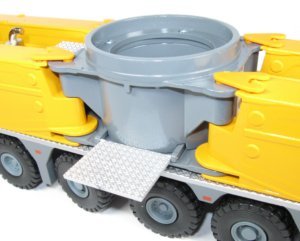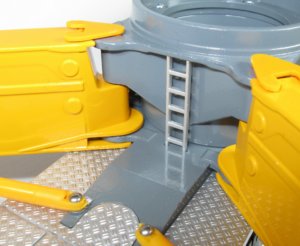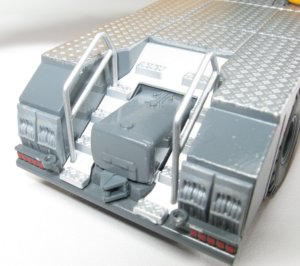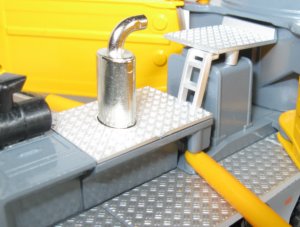
1:50th Scale Liebherr LG1750 Lattice Crane

Presented here is the 1:50th scale Liebherr LG1750 truck mounted lattice boom crane from Conrad. This model has taken a long time to develop and the long wait is certainly worth it. Conrad have once again produced an amazing, highly detailed and very heavy replica of the Liebherr LG1750 which is capable of lifting upto 750 tons.
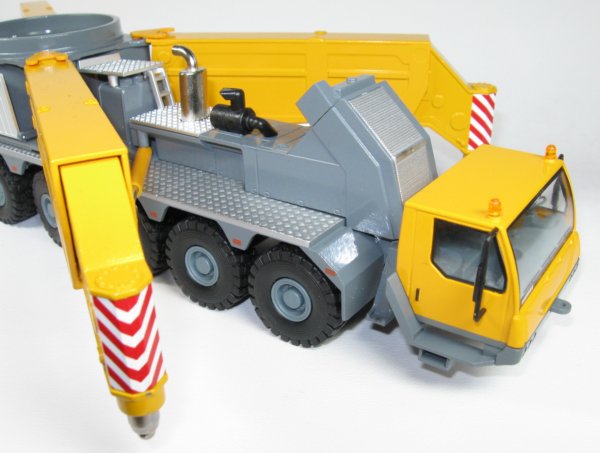
The shape of the carrier with it's 8 axles and huge outriggers with low mounted cab give the machine a very rugged and unusual appearance and this has been fully captured on the model. The large tyres have a rugged tread pattern moulded into the surfaces and each axle features independent steering.
|
|
The centre of the chassis houses the main slewing ring casting where the upper structure connects to the chassis. The design of the coupler has been nicely engineered to allow the two sections to be seperated easily and yet there is enough strength to keep everything rigid.
Small ladders have been fitted to the central section and fold down platforms are fitted on each side to assist in assembling the crane safely.
|
|
The front section houses the engine and a silver exhaust stack along with air filters are mounted to the top of the engine housing along with diamond plate textured floor panels. |
|
|
|
|
|
The rear of the chassis has a towing hitch, access steps on each side of a large tank to the deck, complete with accurate scaled handrails and diamond plate surfaces. Painted indicator and brake lights have been added to the rear frame. |

The four large outriggers are connected to the chassis with large, stiff hydraulics which allow them to hold the position chosen. The two-stage outriggers extend smoothly and click into place when extended and the main jacks have been engineered to hide the screw thread within which is a nice touch. When extended and lowered, the stabilisers are capable of holding the weight of the carrier without any noticable droop of the arms.
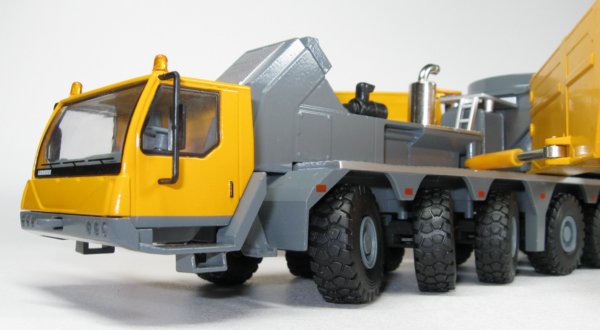
The front cab is mounted low to the ground with access steps cast into the lower frame. The front of the cab has integrated headlights with plastic lenses, printed windscreen wipers on the front windows and amber warning beacons mounted to the cab roof and the interior has been replicated with drivers seat and wrap-round control panel all visible. Rising up behind the cab is the engine's radiator cooling system which has a fine textured grill and silver finish.

The box contains a large number of counterweight slabs and there are certainly more than you would need to display the model. Each one fits together and they are placed in the side mounted trays and suspended counterweight structure.

The box contains a number of boom sections to allow the crane to be erected with full jib, backmast and suspended counterweight tray. The main boom base has two winches mounted into the holders and all the winches need loading with rope which is supplied in the box on five plastic spools. It is much easier to load the ropes before assembling the model and the supplied winding key can be used with a powered screwdriver to make the task much easier.

Two full length main boom sections are supplied along with a single length backmast boom section which all pin together using the push fit plastic pins. Some of these can be a little tight to insert so what I tend to do is gently remove a little paint from the holes in the boom with a small diameter round file. This also has the benefit of making it a little easier to dismantle when required.
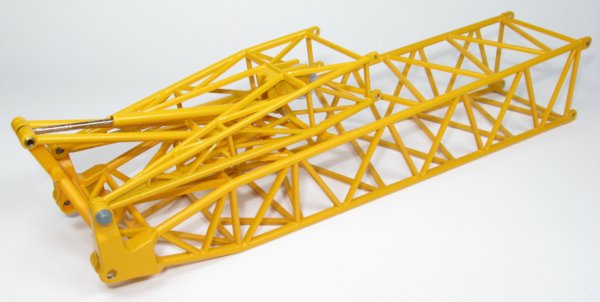
The main jib consists of the base section which connects to the main boom along with two full length sections, end section and boom tip. As with the main boom and backmast, pins are used to assemble the sections.

The engineering of the pennant lines has changed on the LG1750 and each pennant is pinned together with a small plastic pin. This gives the pennants more strength and makes them easier to assemble and join during assembly of the model.

Other components supplied in the box include four plastic stabiliser pads which fit to the ends of the jacks, two metal walkways, complete with safety rails which fit to the upper structure and two hook blocks, a single 10 shieve hook and a double hook block with side fitting weights.

The addition of the walkways gives the model a different look to the original LR1750 and these slide into place easily once the crane has been assembled and the cab positioned into the "work" position.

The rear of the crane has a number of plastic pulleys which need reeving to the rear most mounted double winch. This is quite hard to reeve as the amount of rope on each side of the winch needs to be similar for the model to look good and this can be done before the upper structure is connected to the carrier.

The counterweight holders hang onto the cast lugs of the rear frame and need to be fitted before the suspended counterweight arm is fitted. The crane engine is located at the rear of the upper structure and engine cover panels, complete with fine grill texture have been added both to the underside and top side of the engine bay. Exhaust silencers are mounted to each side of the chassis which are hidden behind the counterweight trays.

The backmast is connected to the A frame using the pennant lines and spring loaded cylinders keep the backmast tensioned to prevent the ropes jumping off the pulleys. To make assembly easier, it is possible to assemble the backmast and reeve the pulley block which connects to the tip of the main boom in situ on a bench as the pulley block has plastic moulded pins that locate into the throat of the pulley assembly at the tip of the backmast.
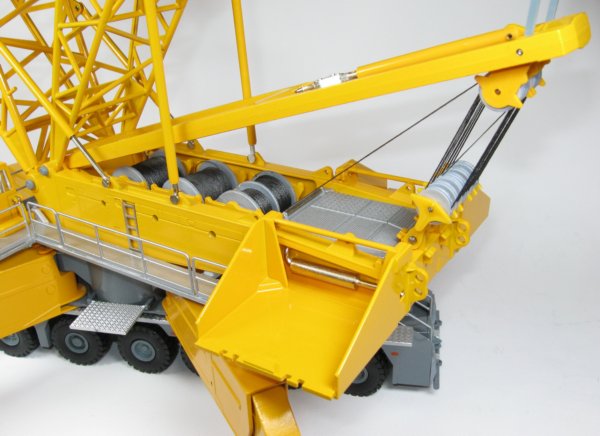
Once assembled, the main mast can be connected to the backmast and this also uses two cylinders with spring loaded pistons to keep tension on the main boom as it is raised into position as required.

It is possible to erect the crane in several different configurations with or without the jib or backmast and this is good for the collectors who do not have enough room to fully erect the crane.

The crane's cab has large windows all round to give the driver an unobstructed view and this allows the replicated interior to be seen. The cab can be tilted back but the cylinder used for this is not stiff enough to hold the cab in the tilted position.

The suspended counterweight tray is pinned into position and linked to the backmast with more pennant lines. The arms that connect to the frame can be extended to move the tray away from the chassis and rest against the rear frame of the crane when fully lowered which ensures that, when fully loaded with counterweight pieces, most of the weight is taken off the pennant lines to prevent them failing.

Metal safety railings are supplied which need fitting into the holes in the frame (As pictured above)

I have found that placing several small pieces of balsa wood below the suspended tray prevents too much strain being placed on the main joint between upperstructure and carrier.

An A4 sized booklet is provided with assembly and rigging instructions and the model is securely packaged in three polystyrene tray sections which fit together, complete with printed outer cardboard sleeve.

The version of the crane reviewed here is available to the collector market and is limited in availability. A different configuration of the model has been produced which is exclusive to the Liebherr Online Shop and consists of the boom sections required to build an SLH version which is typically used for windmill erection.
A Felbermayr version of the model presented here is also being produced along with a matching LR1750 in a very limited production run.
